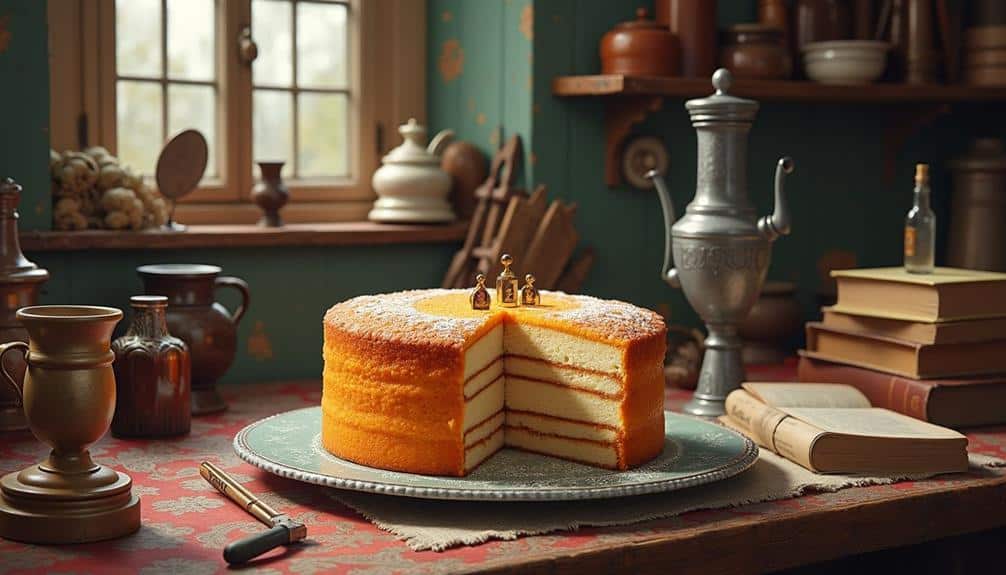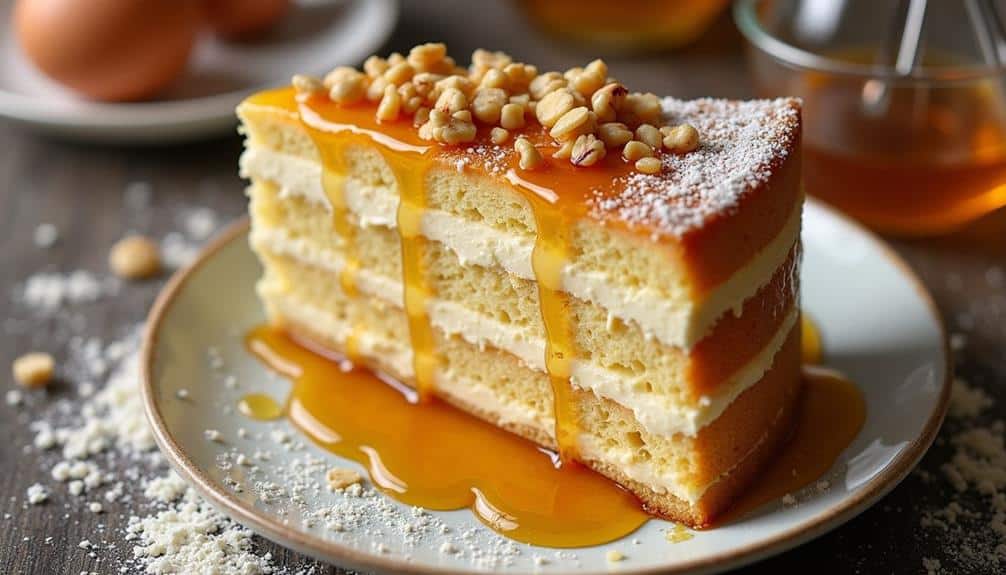The Most Amazing Russian Honey Cake, or Medovik, is a dessert that carries the essence of Russian culinary tradition and hospitality. Originating in the 19th century, this multi-layered delicacy combines honey-infused sponge layers with a rich sour cream frosting. The harmonious blend of sweetness and tanginess, alongside the potential for personalized variations, makes it a culinary masterpiece. But what makes Medovik truly stand out among other desserts? Join us as we explore its fascinating history, the essential ingredients, and discover tips for creating the perfect Medovik at home.
History of Medovik

The history of Medovik, or Russian honey cake, is steeped in tradition and culinary ingenuity. This delectable dessert traces its origins back to the 19th century, during the reign of Emperor Alexander I. Legend has it that one of the emperor’s chefs, unaware of the Empress Elizabeth’s aversion to honey, crafted a honey-infused cake that ultimately delighted her palate, leading to its enduring popularity.
Medovik’s origins are deeply rooted in Russian culture, symbolizing hospitality and festivity. Traditionally, the preparation of Medovik involves multiple thin layers of honey-infused sponge cake, meticulously assembled with a rich, creamy filling. This labor-intensive process reflects the cake’s cultural significance, often being reserved for special occasions such as weddings and holidays.
The meticulous layering and the harmonious blend of flavors serve as an affirmation to the artistry and patience embedded in Russian culinary practices.
Over the years, Medovik has evolved, with regional variations emerging across Eastern Europe. Despite these adaptations, the essence of Medovik remains unchanged, embodying a sense of warmth and celebration.
Its storied past and continued presence in Russian kitchens highlight its enduring appeal, making Medovik a cherished component of Russia’s gastronomic heritage.
Essential Ingredients
Integral to the creation of Medovik, the essential ingredients form the backbone of this celebrated dessert. At the heart of this Russian honey cake lies honey, a natural sweetener that not only imparts a distinct, rich flavor but also offers various health benefits such as antioxidants and antibacterial properties.
Flour and eggs provide the structure, guaranteeing the cake layers are both light and sturdy. Sugar enhances sweetness, while baking soda acts as a leavening agent, contributing to the cake’s airy texture.
Sour cream, often used in the frosting, adds a tangy note that balances the sweetness of honey and sugar. This ingredient is not only delectable but also introduces probiotics, which can aid in digestion.
Butter, another staple, guarantees a moist and tender crumb, enriching the overall taste.
Regional variations exist, with some versions incorporating additional spices like cinnamon or cloves, which add complexity to the flavor profile. In certain areas, condensed milk is used in the cream, making the frosting even more indulgent.
These carefully chosen ingredients, each with its own unique role and potential health benefits, come together to create the iconic Medovik, a dessert that epitomizes Russian culinary artistry.
Step-by-Step Recipe

To bring these carefully selected ingredients together into a harmonious whole, following a structured recipe is paramount.
Begin by whisking together 1 cup of sugar and 3 eggs until the mixture is pale and fluffy. In a separate bowl, melt 3 tablespoons of honey and 1 stick of unsalted butter over a gentle heat. Once melted, allow this mixture to cool slightly before incorporating it into the egg-sugar blend.
Next, sift 3 cups of flour with 1 teaspoon of baking soda, and gradually fold this into the wet mixture, forming a smooth dough. Divide the dough into eight equal portions, rolling each into thin, even circles. Bake these layers at 350°F (175°C) for 5-7 minutes until golden.
For the cream, whip together 2 cups of sour cream, 1 cup of heavy cream, and 1 cup of powdered sugar until soft peaks form. Layer and frost the cake, guaranteeing an even distribution of the cream to allow the flavors to meld beautifully.
Complete your creation with meticulous cake decoration. Consider flavor pairings such as a drizzle of honey or a sprinkle of crushed walnuts, both enhancing the cake’s rich, aromatic profile.
This methodical approach guarantees a cake that is not only visually stunning but also a delight to the palate.
Tips for Perfection
Achieving perfection in crafting a Russian Honey Cake requires attention to detail and adherence to several key tips. First and foremost, precision in your baking techniques is fundamental. Make certain that your layers are consistently thin and evenly baked. This can be achieved by rolling the dough to a uniform thickness and closely monitoring the baking time to avoid overcooking.
Another significant aspect is the balance of flavors. The cake’s signature lies in the interplay between the rich honey layers and the creamy filling. Opt for a high-quality honey, as it profoundly influences the overall taste. Pair the honey with a tangy sour cream or a mixture of sour cream and whipped cream to create a harmonious flavor pairing. This contrast will enhance the sweetness of the honey and add depth to the dessert.
Moreover, allowing the cake to rest is essential. After assembly, refrigerate the cake for at least 24 hours. This resting period enables the flavors to meld together and the layers to soften, resulting in a more cohesive and delightful texture.
Variations to Try

Exploring variations of the traditional Russian Honey Cake can open up a world of delightful possibilities, allowing bakers to put their unique spin on this classic dessert.
One popular approach is to experiment with different flavor combinations. For instance, adding a hint of citrus zest to the honey-sweetened layers can introduce a revitalizing contrast that brightens the cake’s overall profile.
Alternatively, incorporating spices such as cinnamon, nutmeg, or cardamom can provide a warm, aromatic depth that complements the honey’s natural sweetness.
For those seeking festive twists, consider integrating seasonal fruits or nuts. A layer of thinly sliced apples or pears can imbue the cake with a fresh, juicy element, while chopped walnuts or hazelnuts offer a satisfying crunch.
Another intriguing variation is to infuse the cream filling with flavors like lavender or rose water, adding a subtle floral note that elevates the cake to a more sophisticated level.
Serving Suggestions
When it comes to presenting the Russian Honey Cake, thoughtful serving suggestions can enhance its appeal and elevate the dining experience. One effective way to present this dessert is by serving it on a cake stand, which adds height and elegance. Garnishing the cake with a light dusting of powdered sugar or edible gold flakes can further enhance its visual appeal.
For individual servings, consider slicing the cake into neat, uniform pieces and arranging them on a decorative platter.
Flavor pairings are essential in complementing the rich, sweet taste of the Russian Honey Cake. Fresh berries, such as raspberries or strawberries, provide a delightful contrast with their tartness. A dollop of crème fraîche or a side of vanilla ice cream can add a creamy texture that balances the cake’s sweetness. Additionally, a drizzle of berry coulis or a touch of honey can amplify the flavors.
For beverages, pairing the cake with a robust black tea or a dessert wine like Sauternes can further elevate the tasting experience.
These presentation ideas and flavor pairings guarantee that the Russian Honey Cake is not only a visual delight but also a culinary masterpiece, enchanting both the eye and the palate.




